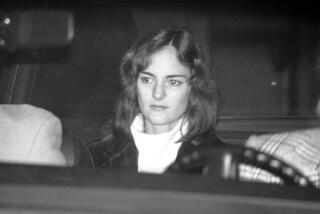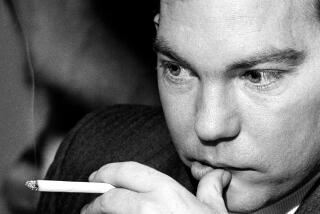A Forgotten Hero From a Night of Disgrace
- Share via
One of the darkest chapters in Los Angeles’ turbulent history left no memorials, but it produced one authentic, though equally unremembered, hero.
The year was 1871, and historians recall the incident, if at all, as simply the “Chinese Massacre,” an event that left 19 Asian immigrants dead and led contemporary newspapers to label the city a “bloodstained Eden.” The only redeeming aspect of the whole squalid affair was the bravery of a young fireman-turned-police patrolman, who would go on to become Los Angeles’ only Jewish police chief.
Emil Harris, a Polish immigrant, had arrived in Los Angeles only two years earlier, quickly helping to establish the city’s first volunteer fire department. In need of a paying job, he hired on as a patrolman--one of six police officers under the leadership of the city marshal. Harris rapidly won a reputation for honesty and competence. He would reinforce the former in the massacre’s wake when he unhesitatingly pointed the finger of blame at an “excited [white] multitude.” He would impress the city with his abilities by capturing the infamous--and dangerous--local bandit Tiburcio Vasquez.
All that was in the future when the young immigrant took the oath to maintain law and order in a town that cared little for either--a place where 30 murders were committed each month. Immediately, Harris was assigned to police the town’s toughest neighborhood, “Calle de los Negros.” It was a 40-foot-wide, block-long stretch of brothels, opium dens, saloons and gambling parlors running through the heart of the city’s first Chinatown. The narrow thoroughfare that led from Aliso Street to the Plaza (where the 101 Freeway is today) already had been labeled a “sinkhole of depravity” by the city’s press.
Things got worse on Oct. 24, 1871, when an ongoing feud between two Chinese gangs--the Hong Chow and Nin Yung tongs--erupted into violence in a dispute over the possession of a young woman named Ya Hit.
Gunfire erupted at 4 p.m., just as former city assessor-turned-patrolman Jesus Bilderrain was polishing off a whiskey at Higby’s saloon. Most of the barroom patrons shrugged off the commotion, but Bilderrain--pistol in hand--dutifully went out the swinging doors into the street. A short distance away, he found a man named Ah Choy shot through the neck. As Bilderrain blew his whistle to summon help, bullets struck him in the shoulder and wrist.
Running to his rescue, saloon owner-turned-rancher Robert Thompson was killed, shot through the heart by the same unseen gunmen, who also wounded some of the bystanders.
Order Goes Out to Shoot
News of the shootings spread rapidly. Inflamed by racial hate and whiskey, an angry mob of 500 Angelenos--some of whom were led by City Councilman George E. Fall--surrounded Chinatown.
Marshal Francis Baker--also the city’s dogcatcher and tax collector--ordered his men to “shoot any Chinese who try to escape.”
Harris, however, refused to obey his superior’s order. He personally captured a hatchet-wielding Chinese immigrant and attempted to escort him to jail, four blocks away. But before Harris could reach his destination, he was set upon by rioting thugs who pinned the patrolman to the ground and dragged his prisoner to the Tomlinson Corral at Temple and Spring streets, where they hanged him.
When the rope broke, the man begged for mercy. Hecklers drowned out his pleas and watched him struggle as he was hanged again.
Cries of “Hang ‘em! Hang ‘em!” soon gave way to “Burn ‘em out!” as someone in the mob hurled a fireball onto a Chinatown rooftop.
Risking the mob’s fury, Harris ran inside, where a group of Chinese had taken refuge, grabbed the torch and flung it into the street.
The rioters, meanwhile, rampaged on. Some climbed to the rooftops and used pickaxes to chop holes, firing through them at the immigrants inside. Two men who ran out into the street were cut down by gunmen on the roofs.
One by one, more victims were hauled from their hiding places, kicked, beaten, stabbed, shot and tortured by their captors. Some were dragged through the streets with ropes around their necks and hanged from a wooden awning over a sidewalk, a covered wagon or the crossbeam of a corral gate. Finally, 15 corpses--including those of a 14-year-old boy and the Chinese community’s only physician, Chee Long Tong--dangled in the City of the Angels. Four others died from gunshot wounds, bringing the death toll at the hands of the mob to 19--10% of the city’s tiny Chinese population.
Then, every rickety shanty in Chinatown was looted. “Boys, help yourselves,” was the cry. One lynching victim’s finger was cut off for the diamond ring he wore.
The leaders of the massacre paraded through the streets, displaying their booty, to the laughter and praise of the mob. An estimated $40,000 in cash, gold and jewels was stolen.
The next day’s local newspapers called the riot a “victory of the patriots over the heathens.”
During the subsequent coroner’s inquest and grand jury hearings, police and other city officials--fearful of being labeled “Chinese lovers”--shielded the guilty. “I didn’t recognize anyone” was the recurring statement.
Then, Harris and a handful of others said that the only Chinese to commit a crime that night were those who murdered Thompson. The blame for all that followed, they testified, was squarely on the shoulders of the mob and its leaders.
There were no other witnesses, since discriminatory state legislation then prohibited Chinese from testifying in California courts. Still, 37 rioters were indicted, 15 tried and eight convicted of manslaughter. A little more than a year later, however, the California Supreme Court reversed the convictions on the grounds that the original indictment had failed to establish that the Chinese physician had been murdered.
An embarrassed U.S. government subsequently paid imperial China an indemnity to settle the whole affair.
In 1877, Los Angeles Street was widened and extended, and “Calle de los Negros” was no more. That same year, two days before his 38th birthday, Harris was named Los Angeles’ police chief by the City Council.
Framed by a deputy who falsely accused him of buying votes, Harris resigned at the end of his one-year term. The following year, he opened the city’s first professional private detective agency in a building in what is now the Hall of Justice parking lot. He soon became a master detective known for his clever disguises.
He died in 1921 at age 82 and was buried at the Home of Peace cemetery. There, his stone marker bears two stars above his name: a six-pointed Star of David and a badge engraved LAPD1.
More to Read
Sign up for Essential California
The most important California stories and recommendations in your inbox every morning.
You may occasionally receive promotional content from the Los Angeles Times.










